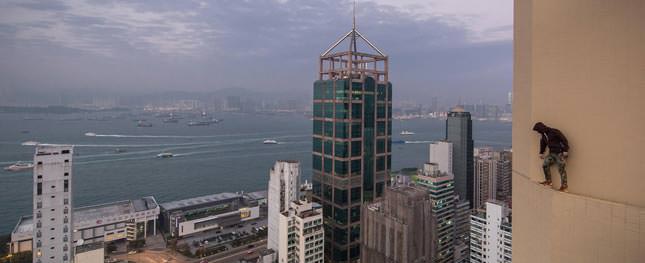Daring 'urban explorers' get high on history

HONG KONG – Dangling his feet off the edge of a skyscraper more than 50 stories above the streets of Hong Kong, Jonathan Tsang looks as relaxed as if he was kicking back in his own living room.For most people the view below would be a dizzying, terrifying spectacle. But for 25-year-old Tsang, it brings a sense of calm. "The population is really dense and sometimes it's just kind of suffocating to the point where you need some time to yourself," he said. "That's mostly why I come up here." Tsang, who asked AFP to use a pseudonym, is one of a growing number of so-called "urban explorers," a subculture of adrenaline junkies, photographers and history enthusiasts who treat the world's forgotten and often forbidden places as their own personal playgrounds.The pursuit has long been popular in North America and Europe, and now Asia is becoming an increasingly sought after destination for an intrepid new generation of "urbexer."In February, two Russian daredevils scaled China's tallest building with their bare hands. Vadim Makhorov and Vitaliy Raskalov took advantage of lax security over the Chinese New Year holiday to sneak into the underconstruction Shanghai Tower, releasing a hair-raising video of their stunt that went viral.Hong Kong, a city with more skyscrapers than anywhere else in the world, is a particularly attractive destination for both local and international rooftoppers, a daring subset of adventurers with a head for heights willing to risk arrest, injury and even death as they scale some of the world's tallest buildings.Getting to the top of many Hong Kong residential buildings, said Tsang, is often as easy as bluffing your way past the concierge and taking a lift to the top floor. But some of the tallest luxury complexes, hotels and office towers present a much greater challenge. "You try and do as much research as you can. If other explorers have been there then you can get advice about how to get in, like whether there is a hole in a fence somewhere," he said. "Usually there are security guards but you just have to be patient. You can't just barge into a place and walk up to the roof. You have to wait for the right time," he continued. Many attempts end in failure. "The success rate on rooftops is probably 20 to 30 percent," he said. "And at times it can be discouraging. You might walk up 30 to 40 stories and then you discover you can't get past the final door. But when you do finally get to the top, wow, it's hard to describe. It's just beautiful." Accessing the roof of the skyscraper, a luxury hotel in the city's bustling Kowloon district, was alarmingly easy.Tsang and an urbexing friend who uses her exploring name Airin T simply walked through a mall, into the hotel and took an elevator most of the way up. To avoid any guards or staff near the more exclusive penthouse suites, the last few stories were made on foot via a staircase and through an unlocked door that led to the roof. But any misconception that rooftopping is a safe hobby was soon dispelled as Tsang and his friend climbed a large illuminated dome at the top of the building. The ladder up to the dome hung over the edge of the skyscraper while the pathway at the top was little more than a foot wide. A slip on either would mean certain death. "I do have a fear of heights," said Tsang, visibly elated from his climb. "It sounds kind of clichéd but it's about facing your fears. And it really does help."Hong Kong's police declined an interview request by AFP but warned that practitioners could face criminal damage and burglary charges in the event of any destruction of property.No explorers have been prosecuted to date. Yet not all forms of urban exploration are about seeking the adrenaline rush that comes from soaring above the crowds on towering rooftops.Airin, a 25-year-old office worker by day, is a keen rooftopper. But she also spends much of her time exploring Hong Kong's myriad of abandonments, from shuttered mental asylums to discarded factories and crumbling apartment blocks.
Last Update: March 14, 2014 02:10
